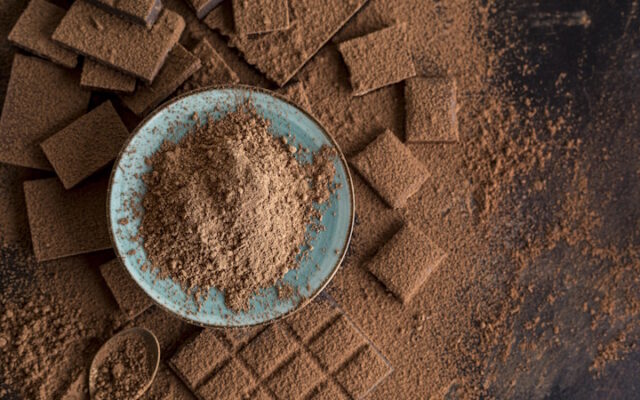
By Amelia Lucas
There’s pricing pressure taking hold of a specific corner of global agriculture — and it’s bittersweet.
Prices of cocoa have more than tripled over the last year, creating a big headache for candy makers and other food companies that use the ingredient to make chocolate.
In recent years, the price of cocoa had hovered at around $2,500 per metric ton. But reports of a weaker-than-expected crop set off concerns about supply, sparking the commodity’s run-up in recent months. Cocoa hit an all-time high of more than $11,000 per metric ton in April. The price surge has since eased off slightly, but the crop is still commanding well above what food companies are used to paying.
For now, many of the largest candy companies — Hershey, M&M’s maker Mars, Kinder owner Ferrero and Cadbury parent Mondelez — are likely protected from higher cocoa costs, thanks to long-term contracts that lock in the prices they pay for key commodities to protect them from events just like this. That gives them some lead time to grapple with the issue. But come 2025, they’ll likely end up paying much more for their cocoa.
“This is absolutely impacting the ways in which these companies are managing their businesses, just because the cost impact is so incredibly significant,” said Steve Rosenstock, the consumer products lead at Clarkston Consulting, which advises clients on how to deal with problems such as the soaring cost of cocoa.
Mars declined to participate for this story. Mondelez, Ferrero and Hershey did not respond to CNBC’s requests for comment.
Costly cocoa

West Africa, which grows the majority of the world’s cocoa supply, has been hit by crop disease and lower prices paid to farmers at the point of sale, called farmgate pricing, that push them to grow more lucrative crops such as rubber instead of cocoa. This season’s cocoa crop is expected to experience the largest deficit in at least six decades, according to a Rabobank report from May.
Reuters reported Wednesday that Ghana, the second-largest cocoa producer, is looking to delay a delivery of up to 350,000 tons of beans to next season, sending prices higher again.
On recent earnings calls, executives from Mondelez and Hershey said they believe market speculation is driving at least some of the surge in cocoa. Prices could come down in September, once more information about the new crop is available — but that doesn’t mean that they’ll return to normal.
The commodity’s climbing cost comes at a tough time for many food companies. Over the last two years, many have raised prices to deal with inflation that touched on a broader array of commodities. As a result, shoppers have become choosier about what they buy and more dissatisfied with the prices they see at grocery stores. Consumers’ focus on value leaves candy companies with little leeway when it comes to pricing to cope with cocoa’s higher cost.
And then there’s shrinkflation, a buzz word that has entered the layperson’s lexicon over the last two years. Companies will cut a product’s quantity or weight while the price stays the same. But consumers have gotten wise to the trick. A YouGov survey conducted in October found that 72% of U.S. respondents had noticed shrinkflation in food products.
Near-term workarounds
As a result, many companies will have to become more creative.
J&J Snack Foods CEO Daniel Fachner has been keeping an eye on cocoa and chocolate prices. The company owns brands including Dippin’ Dots, SuperPretzel and Hola Churros and manufactures products for other companies, such as Subway’s footlong churro. Chocolate is a common flavor in its portfolio, which includes treats such as a chocolate-filled churro.
“It won’t stop us from using chocolate, but it will cause us to think about and say, ‘Now, if we do this innovation with that new pricing, is it sellable?’ And then when we sell it, ‘Is it at a low enough cost that customer could sell it and still make a good margin?’” Fachner told CNBC in May.
One hypothetical solution, proposed by Fachner, could involve cutting back the number of chocolate chips from 12 to nine in a certain product. He also said J&J is looking for any possible substitutes that could work for some of its recipes.
“This one has extra peanut butter, so it’s a nice way of trying to get innovation into the market at a premium price, let the consumer feel like they’re getting value, but just changing the product itself to lower the reliance on chocolate,” he said.
For food companies that don’t primarily deal in chocolate, they might start avoiding the flavor, especially when it comes to new products.
“I think more or less, people will try to stay away from chocolate at this point,” Modi said.
The long tail of the cocoa crisis
Disclaimer
The information contained in South Florida Reporter is for general information purposes only.
The South Florida Reporter assumes no responsibility for errors or omissions in the contents of the Service.
In no event shall the South Florida Reporter be liable for any special, direct, indirect, consequential, or incidental damages or any damages whatsoever, whether in an action of contract, negligence or other tort, arising out of or in connection with the use of the Service or the contents of the Service. The Company reserves the right to make additions, deletions, or modifications to the contents of the Service at any time without prior notice.
The Company does not warrant that the Service is free of viruses or other harmful components
This article originally appeared here and was republished with permission.












